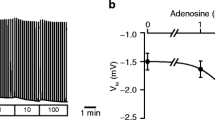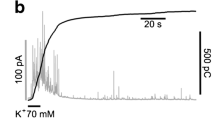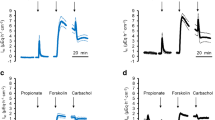Abstract
Cl− secretion in HT29 cells is regulated by agonists such as carbachol, neurotensin and adenosine 5′-triphosphate (ATP). These agonists induce Ca2+ store release as well as Ca2+ influx from the extracellular space. The increase in cytosolic Ca2+ enhances the Cl− and K+ conductances of these cells. Removal of extracellular Ca2+ strongly attenuates the secretory response to the above-mentioned agonists. The present study utilises patch-clamp methods to characterise the Ca2+ influx pathway. Inhibitors which have been shown previously to inhibit non-selective cation channels, such as flufenamate (0.1 mmol·l−1, n=6) and Gd3+ (10 μmol·l−1, n=6) inhibited ATP (0.1 mmol·l−1) induced increases in whole-cell conductance (G m). When Cl− and K+ currents were inhibited by the presence of Cs2SO4 in the patch pipette and gluconate in the bath, ATP (0.1 mmol·l−1) still induced a significant increase in G m from 1.2±0.3 nS to 4.7±1 nS (n=24). This suggests that ATP induces a cation influx with a conductance of approximately 3–4 nS. This cation influx was inhibited by flufenamate (0.1 mmol·l−1, n=6) and Gd3+ (10 μmol·l−1, n=9). When Ba2+ (5 mmol·l−1) and 4,4′-diisothiocyanatostilbene-2-2′-disulphonic acid (DIDS, 0.1 mmol·l−1) were added to the KCl/K-gluconate pipette solution to inhibit K+ and Cl− currents and the cells were clamped to depolarised voltages, ATP (0.1 mmol·l−1) reduced the membrane current (I m) significantly from 86±14 pA to 54±11 pA (n=13), unmasking a cation inward current. In another series, the cation inward current was activated by dialysing the cell with a KCl/K-gluconate solution containing 5–10 mmol·l−1 1,2-bis-(2-aminoethoxy)ethane-N,N,N′,N′-tetraacetic acid (EGTA) or 1,2-bis-(2-aminophenoxy) ethane-N,N,N′,N′-tetraacetic acid (BAPTA). The zero-current membrane voltage (V m) and I m (at a clamp voltage of +10 mV) were monitored as a function of time. A new steady-state was reached 30–120 s after membrane rupture. V m depolarised significantly from −33±2 mV to −12±1 mV, and I m fell significantly from 17±2 pA to 8.9±1.0 pA (n=71). This negative current, representing a cation inward current, was activated when Ca2+ stores were emptied and was reduced significantly (ΔI m) when Ca2+ and/or Na+ were removed from the bathing solution: removal of Ca2+ in the absence of Na+ caused a ΔI m of 5.0±1.2 pA (n=12); removal of Na+ in the absence of Ca2+ caused a ΔI m of 12.8±3.5 pA (n=4). The cation inward current was also reduced significantly by La3+, Gd3+, and flufenamate. We conclude that store depletion induces a Ca2+/Na+ influx current in these cells. With 145 mmol·l−1 Na+ and 1 mmol·l−1 Ca2+, both ions contribute to this cation inward current. This current is an important component in the agonist-regulated secretory response.
Similar content being viewed by others
References
Aloj SM, Liguoro D, Kiang JG, Smallridge RC (1993) Purinergic (P2) receptor-operated calcium entry into rat thyroid cells. Biochem Biophys Res Commun 195:1–7
Alvarez J, Montero M, Garcia-Sancho J (1994) Agonist-induced Ca2+ influx in human neutrophils is not mediated by production of inositol polyphosphates but by emptying of intracellular Ca2+ stores. Biochem Soc Trans 22:809–813
Bird GSJ, Putney JW (1993) Inhibition of thapsigargin-induced calcium entry by microinjected guanine nucleotide analogues. J Biol Chem 268:21486–21488
Bode HP, Göke B (1994) Protein kinase C activates capacitative calcium entry in the insulin secreting cell line RINm5F. FEBS Lett 339:307–311
Clementi E, Scheer H, Zacchetti D, Fasolato C, Pozzan T, Meldolesi J (1992) Receptor-activated Ca2+ influx. J Biol Chem 267:2164–2172
Fasolato C, Hoth M, Matthews G, Penner R (1993) Ca2+ and Mn2+ influx through receptor-mediated activation of nonspecific cation channels in mast cells. Proc Natl Acad Sci USA 90:3068–3072
Fasolato C, Hoth M, Penner R (1993) Multiple mechanisms of manganese-induced quenching of fura-2 fluorescence in rat mast cells. Pflügers Arch 423:225–231
Fasolato C, Hoth M, Penner R (1993) A GTP-dependent step in the activation mechanism of capacitative calcium influx. J Biol Chem 268:20737–20740
Franzius D, Hoth M, Penner R (1994) Non-specific effects of calcium entry antagonists in mast cells. Pflügers Arch 428:433–438
Gögelein H, Dahlem D, Englert HC, Lang HJ (1990) Flufenamic acid, mefenamic acid and niflumic acid inhibit single nonselective cation channels in the rat exocrine pancreas. FEBS Lett 268:79–82
Hoth M, Penner R (1992) Depletion of intracellular calcium stores activates a calcium current in mast cells. Nature 355:353–355
Hoth M, Penner R (1993) Calcium release-activated calcium current in rat mast cells. J Physiol (Lond) 465:359–386
Illek B, Fischer H, Machen TE (1992) Intracellular Ca2+ signalling is modulated by K+ channel blockers in colonic epithelial cells (HT-29/B6). Pflügers Arch 422:48–54
Irvine RF (1991) Inositol tetrakisphosphate as a second messenger: confusions, contradictions, and a potential resolution. Bioessays 13:419–427
Jaconi MEE, Lew DP, Monod A, Krause KH (1993) The regulation of store-dependent Ca2+ influx in HL-60 granulocytes involves GTP-sensitive elements. J Biol Chem 268:26075–26078
Jenner S, Farndale RW, Sage SO (1994) The effect of calciumstore depletion and refilling with various bivalent cations on tyrosine phosphorylation and Mn2+ entry in fura-2-loaded human platelets. Biochem J 303:337–339
Kass GEN, Llopis J, Chow SC, Duddy SK, Orrenius S (1990) Receptor-operated calcium influx in rat hepatocytes. J Biol Chem 265:17486–17492
Klär B, Leipziger J, Nitschke R, Greger R (1993) Ca2+ as a second messenger in CFPAC-1 cells. Cell Physiol Biochem 3:17–27
Koch BD, Faurot GF, Kopanitsa MV, Swinney DC (1994) Pharmacology of a Ca2+-influx pathway activated by emptying the intracellular Ca2+ stores in HL-60 cells: evidence that a cytochrome P-450 is not involved. Biochem J 302:187–190
Koike Y, Ozaki Y, Qi R, Satoh K, Kurotak Y, Kume S (1994) Phosphatase inhibitors suppress Ca2+ influx induced by receptor-mediated intracellular Ca2+ store depletion in human platelets. Cell Calcium 15:381–390
Kubitz R, Warth R, Allert N, Kunzelmann K, Greger R (1992) Small conductance chloride channels induced by cAMP, Ca2+, and hypotonicity in HT29 cells: ion selectivity, additivity, and stilbene sensitivity. Pflügers Arch 421:447–454
Kunzelmann K, Kubitz R, Grolik M, Warth R, Greger R (1992) Small conductance Cl− channels in HT29 cells: activation by Ca2+, hypotonic cell swelling and 9-Br-cGMP. Pflügers Arch 421:238–246
Kunzelmann K, Tilmann M, Greger R (1992) Ion transport in HT29 colonic carcinoma cells. Adv Comp Envir Physiol 16:237–251
Kwan CY, Putney JW (1990) Uptake and intracellular sequestration of divalent cations in resting and methacholine-stimulated mouse lacrimal acinar cells. J Biol Chem 265:678–684
Lee KM, Toscas K, Villereal ML (1993) Inhibition of bradykinin- and thapsigargin-induced Ca2+ entry by tyrosine kinase inhibitors. J Biol Chem 268:9945–9948
Leipziger J, Nitschke R, Greger R (1991) Transmitter-induced changes in cytosolic Ca2+ -activity in HT29 cells. Cell Physiol Biochem 1:273–285
Lohrmann E, Greger R (1995) The effect of secretagogues on ion conductances of in vitro perfused isolated rabbit colonic crypts. Pflügers Arch 429:494–502
Lückhoff A, Clapham DE (1992) Inositol 1,3,4,5-tetrakisphosphate activates an endothelial Ca2+-permable channel. Nature 355:356–358
Lückhoff A, Clapham DE (1994) Calcium channels activated by depletion of internal calcium stores in A431 cells. Biophys J 67:177–182
Marty A, Neher E (1983) Tight-seal whole-cell recording. In: Sakmann B, Neher E. (eds) Single-channel recording. Plenum, New York, pp 107–122
Merritt JE, Jacob R, Hallam TJ (1989) Use of manganese to discriminate between calcium influx and mobilization from internal stores in stimulated human neutrophils. J Biol Chem 264:1522–1527
Montero M, Alvarez J, Garcia-Sancho J (1991) Agonist-induced Ca2+ influx in human neutrophils is secondary to the emptying of intracellular calcium stores. Biochem J 277:73–79
Morris AP, Gallacher DV, Irvine RF, Petersen OH (1987) Synergism of inositol trisphosphate and tetrakisphosphate in activating Ca2+-dependent K+ channels. Nature 330:653–655
Nilius B, Schwarz G, Oike M, Droogmans G (1993) Histamine-activated, non-selective cation currents and Ca2+ transients in endothelial cells from human umbilical vein. Pflügers Arch 424:285–293
Nitschke R, Leipziger J, Greger R (1993) Agonist induced intracellular Ca2+ transients in HT29 cells. Pflügers Arch 423:519–526
Nitschke R, Riedel A, Benning N, Leipziger J, Greger R (1995) Changes of intracellular pH induce alterations of [Ca2+]i in HT29 cells. Pflügers Arch 429:R55
Oike M, Gericke M, Droogmans G, Nilius B (1994) Calcium entry activated by store depletion in human umbilical vein endothelial cells. Cell Calcium 16:367–376
Parekh AB, Terlau H, Stühmer W (1993) Depletion of InsP3 stores activates a Ca2+ and K+ current by means of a phosphatase and a diffusible messenger. Nature 364:814–818
Pusch M, Neher E (1988) Rates of diffusional exchange between small cells and a measuring patch pipette. Pflügers Arch 411:204–211
Putney JW (1993) Excitement about calcium signaling in inexcitable cells. Science 262:676–678
Putney JW, Bird GSJ (1993) The signal for capacitative calcium entry. Cell 75:199–201
Randriamampita C, Tsien RY (1993) Emptying of intracellular Ca2+ stores releases a novel small messenger that stimulates Ca2+ influx. Nature 364:809–814
Sage SO, Mahaut-Smith MP, Rink TJ (1992) Calcium entry in nonexcitable cells: lessons from human platelets. News Physiol Sci 7:108–113
Sargeant P, Farndale RW, Sage SO (1993) ADP- and thapsigargin-evoked Ca2+ entry and protein-tyrosine phosphorylation are inhibited by the tyrosine kinase inhibitors genistein and methyl-2,5-dihydroxycinnamate in fura-2-loaded human platelets. J Biol Chem 268:18151–18156
Sasaki T, Gallacher DV (1990) Extracellular ATP activates receptor-operated cation channels in mouse lacrimal acinar cells to promote calcium influx in the absence of phosphoinositide metabolism. FEBS Lett 264:130–134
Schumann S, Greger R, Leipziger J (1994) Flufenamate and Gd3+ inhibit stimulated Ca2+ influx in the epithelial cell line CFPAC-1. Pflügers Arch 428:583–589
Tsunoda Y, Stuenkel EL, Williams JA (1990) Characterization of sustained [Ca2+]i increase in pancreatic acinar cells and its relation to amylase secretion. Am J Physiol 259:G792-G801
Vaca L, Kunze DL (1993) Depletion and refilling of intracellular Ca2+ stores induce oscillations of Ca2+ current. Am J Physiol 264:H1319-H1322
Wangemann P, Wittner M, Di Stefano A, Englert HC, Lang HJ, Schlatter E, Greger R (1986) Cl−-channel blockers in the thick ascending limb of the loop of Henle. Structure activity relationship. Pflügers Arch 407[Suppl 2]:S128-S141
Wilson OI, Marriott I, Mahaut-Smith MP, Hymel LJ, Mason MJ (1994) Isolation and characterization of membrane potential changes associated with release of calcium from intracellular stores in rat thymic lymphocytes. J Membr Biol 137:159–168
Wolff T, Leipziger J, Fischer KG, Klär B, Nitschke R, Greger R (1993) Evidence for agonist induced export of intracellular Ca2+ in epithelial cells. Pflügers Arch 424:423–430
Xu X, Star RA, Tortorici G, Muallem S (1994) Depletion of intracellular Ca2+ stores activates nitric-oxide synthase to generate cGMP and regulate Ca2+ influx. J Biol Chem 269:12645–12653
Yule DI, Kim ET, Williams JA (1994) Tyrosine kinase inhibitors attenuate “capacitative” Ca2+ influx in rat pancreatic acinar cells. Biochem Biophys Res Commun 202:1697–1704
Zweifach A, Lewis RS (1993) Mitogen-regulated Ca2+ current of T lymphocytes is activated by depletion of intracellular Ca2+ stores. Proc Natl Acad Sci USA 90:6295–6299
Author information
Authors and Affiliations
Rights and permissions
About this article
Cite this article
Kerst, G., Fischer, K.G., Normann, C. et al. Ca2+ influx induced by store release and cytosolic Ca2+ chelation in HT29 colonic carcinoma cells. Pflugers Arch. 430, 653–665 (1995). https://doi.org/10.1007/BF00386159
Received:
Revised:
Accepted:
Issue Date:
DOI: https://doi.org/10.1007/BF00386159




